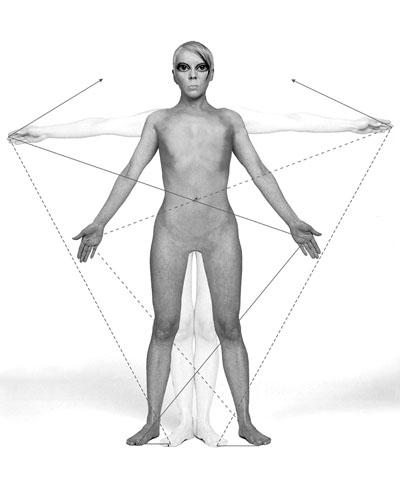| << | CFront - The Newspaper - p. 3 | >> |
Barbara Konopka's "Binary Man"
(excerpts, as published in the newspaper - see also the full text)
£ukasz Ronduda, £odz, 21 August 2000
"Those who make it impossible for unity to develop are the makers of angels."
James Joyce
Thanks to the redundance of the modified version of the portrait, Barbara Konopka shows its mechanism as a stuffy space for the production of a split personality - as the slit between the cognitive subject and its object (which are supposed to be identical in this case) where the “I” is wrought. “[...] Even when the other is only me, me playing the part of another “me” in a double role: of the sender and of the receiver. Between those two roles, between me and the others (even if I am “them” myself), a split appears which makes any completeness of identity quite impossible.” (*) The abovementioned split becomes the internal space for the ever repeated attempts at constructing the identity of the subject. The real world becomes only an element of the internal psychomachia within this space. The solipsistic relation is the reason why man as a being for himself is not able any more to enter the optimal interpersonal relations. The on-going privatization of society and the separation of man from other people lead him to create his internal space of the superego, where he feels an exile. When Barbara Konopka exorcises the “I” in a multiple portrait she gives up the prerogatives of the subject lost in the nuances of its own interior in order to introduce the figure of a binary man in her series of digital photograms called “Illuminations. On-line.” The binary man becomes the material used to form virtual subjectivities in their relation with the exterior, with the other, not with the Identical. Konopka presents the binary man as a double being, empirical and transcendental, made up of two bodies - the physical and the media body. The binary man as a set of analytically atomized physical and mental elements forms the potential for the constitution of subjectivity. It is the frame in whose space osmoses and interphases take place and where ephemeral identities crystallize as the result of contacting any given other. Constant movement, nomadic dismemberment and the location in space makes the binary man a phenomenon which constantly improves and broadens its communicative potential. The possibility of permanent transgression and personality transformation denies thinking in terms of identity-as-foundation.
(*) M.P. Markowski, "Efekt inskrypcji. Jacques Derrida", p. 396 |

| << | CFront - The Newspaper - p. 3 | >> |
